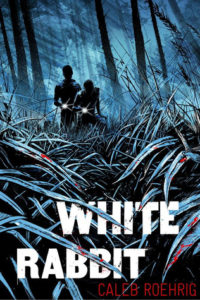
Caleb Roehrig
Feiwel & Friends
Published on April 24, 2018

Amazon | Barnes & Noble | Goodreads
About White Rabbit
Rufus Holt is having the worst night of his life. It begins with the reappearance of his ex-boyfriend, Sebastian—the guy who stomped his heart out like a spent cigarette. Just as Rufus is getting ready to move on, Sebastian turns up out of the blue, saying they need to “talk.” Things couldn’t get much worse, right?
But then Rufus gets a call from his sister April, begging for help. And then he and Sebastian find her, drenched in blood and holding a knife, beside the dead body of her boyfriend, Fox Whitney.
April swears she didn’t kill Fox—but Rufus knows her too well to believe she’s telling him the whole truth. April has something he needs, though, and her price is his help. Now, with no one to trust but the boy he wants to hate yet can’t stop loving, Rufus has one night to prove his sister’s innocence…or die trying.
My Review
It’s been a while since I read a book purely for the fun of it, but I think I needed this book. It was so much fun to read. I got carried away by mystery elements and the complex relationships between characters.
As the story progressed and Rufus drew closer and closer to the murderer, things got more and more dangerous. I was totally biting my nails and practically jumping at every noise while I read. Add to that the fact that Rufus has this really fabulous voice, which again made it great fun to read. I loved the side comments and the way the dialogue gave these light moments away from the tension without disrupting the storytelling.
I loved that Rufus (okay, first, I loved that he’s called Rufus. There aren’t enough Rufus characters in literature. Love it!) battles this deep anger, part of which seems perhaps hereditary and part of which might be environmental. But he doesn’t just make excuses about Hulking out. He recognizes how damaging it can be and really wrestles with his angry impulses. That made him so easy to understand and so admirable to me.
Also, I loved his relationship with his mom. It felt very real, and I felt like there was this great balance in the story where she was there, and obviously a big force in Rufus’s life, but the relationship with her didn’t dominate the story. I also loved the moment where one character has to confront a family member about a secret he’s been keeping. He’s worried the family member will reject him over it to the point that he’s expecting to lose the relationship. And instead, the family member talks about how they love him no matter what. We need those kinds of stories and moments, and the reminders that there are good parents out there, and that sometimes we expect to be rejected but are instead surprised by love and acceptance.
Anyway, I read this book in less than a day, I think. I had so much fun reading it, and I absolutely want to read Roehrig’s other book, LAST SEEN LEAVING.
Cultural Elements
Rufus and Sebastian are both gay. Sebastian is black.
Profanity/Crude Language Content
Regular use of extreme profanity.
Romance/Sexual Content
Kissing between two boys. References to sex. Some details leading up to the event. Some sexual comments.
Spiritual Content
None.
Violent Content
Rufus has some pretty serious anger management issues which he speaks pretty candidly about. He’s trying his best to manage via medication and other healthy strategies, but he’s still bearing some consequences from fights in his past. In several scenes he’s very tempted to fight again. At one point a man threatens him and handles him pretty roughly. A couple characters are downright physically threatening. Someone fires a gun at another person in two scenes. A character threatens others with a gun in another scene. More than one character gets drugged.
Drug Content
Teen alcohol use is pretty normalized. Some references to smoking pot. References to a dangerous psychedelic drug that causes some violent outbursts.